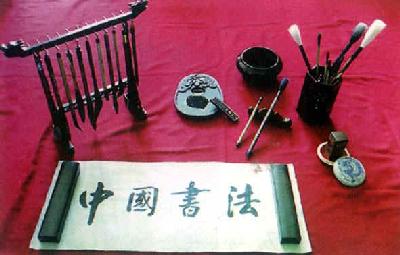 |
| The four treasures of the study |
When talking about the writing utensils of Chinese characters, people often first think of the four treasures of the study, i.e. brush, ink stick, ink slab and paper. Among them, paper is the carrier of writing, and brush is the main writing tool. Besides brush and ink, the writing utensils of Chinese characters include graver,
Jijue(knife used for engraving on metals and stones), etc.
Textual researches find that scripts on porcelain ware of about six to seven thousand years ago found in Banpo of Xi'an City, Dawenkou of Shandong Province and other places have several patterns, such as patterns of human faces and swimming fishes, and so on, which were drawn with a similar tool similar to pen. It proves that the brush prevalent in later period had formed its rudiment at that time. The oldest brush extant today is the brush made in the Chu State of the late Spring and Autumn Period (770-476BC). The brush handle is a solid bamboo rod, and its one end is cleaved with brush hair inserted there. The cleaved part is hooped tightly with thin thread. A layer of paint is applied to the brush handle. The brush hair is made of very good rabbit hair about 2.5 cm long. Around the Qin (221-206BC) and Han (206BC-220AD) dynasties, people also used wood to make brush handle. After the Han Dynasty, the making technique of brush almost remained the same, and the materials included ivory, colored glaze, mottled bamboo, jade pipe and rhinoceros horn, as well as hair of rabbit, goat, deer, wolf, horse, tiger and so on.
It requires a more unyielding engraving tool in order to write on metals, stones, tortoise shells, animal bones and other hard materials. In the scripts on porcelain ware six to seven thousand years ago, the engraving tool might be made of jade or animals' teeth. As for the scripts on tortoise shells and animal bones, scholars generally believe that the most possible engraving tool was bronze cutting tool. Similar engraving tools includeJijue, graver, and iron pen which emerged in comparatively late period. The graver used in seal cutting today appeared at least as early as in the Warring States Period (475-221BC). Because it was inconvenient to write Chinese characters and took much time and energy to complete a comparatively long article or do a lot of recording work with engraving tools, the engraving tools gradually retreated from the realm of ordinary writing and recording, and were only used in a limited area after the Shang (17th-11thcentury BC) and Zhou (11thcentury -256BC) dynasties.
With the improving social life and cultural level in modern times, brush was gradually replaced by fountain pen, ballpoint pen and other hard-tipped pens. However, as the most important writing utensil, brushes are still used by calligraphers and they will not phase out with changes of times.
